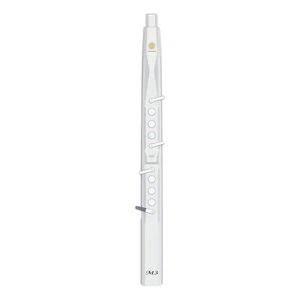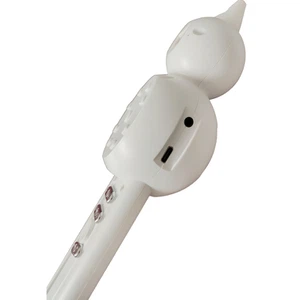In the world of music, finding the right instrument to start one's musical journey is crucial. For beginners, electronic woodwind instruments offer a host of advantages that make them a particularly friendly choice.
I. Introduction to Electronic Woodwind Instruments
Electronic woodwind instruments, often abbreviated as EWIs, combine the traditional playing style of woodwind instruments with advanced electronic technology. These instruments can mimic the sounds of various woodwind instruments such as saxophones, flutes, clarinets, and more. They typically feature a mouthpiece, keys or buttons for fingering, and various controls for adjusting parameters like volume, tone, and pitch.
Unlike traditional woodwind instruments, which rely on the player's breath and physical manipulation to produce sound, electronic woodwind instruments use sensors and digital processing to create and manipulate sounds. This allows for a more consistent and controllable playing experience, which can be especially beneficial for beginners.
II. Advantages for Beginners
A. Easier to Play
Stable Pitch and Intonation
One of the main challenges for beginners on traditional woodwind instruments is achieving consistent pitch and intonation. Electronic woodwind instruments, on the other hand, often have built-in pitch correction and tuning features. This means that beginners can focus on learning the basics of playing without having to worry as much about hitting the correct notes.
For example, some EWIs have a visual pitch indicator or a digital tuner that helps the player stay in tune. This can be a huge confidence booster for beginners and can help them develop a better ear for pitch.
Reduced Physical Demands
Playing traditional woodwind instruments can be physically demanding, requiring a certain amount of breath control and finger strength. Electronic woodwind instruments are often designed to be more ergonomic and require less physical effort to play.
For instance, the keys or buttons on an EWI may be lighter and more responsive than those on a traditional instrument, making it easier for beginners to press them down. Additionally, some EWIs have adjustable breath sensitivity settings, allowing the player to customize the instrument's response to their breathing.
B. Versatility and Creativity
Multiple Sounds and Effects
Electronic woodwind instruments offer a wide range of sounds and effects that can inspire creativity and exploration. Beginners can experiment with different instrument sounds, such as saxophone, flute, clarinet, or even sounds from other musical genres like rock or electronic music.
This versatility allows beginners to find a sound that they are passionate about and can help keep them engaged in the learning process. For example, a beginner who is interested in jazz might start by playing a saxophone sound on their EWI and then explore different jazz styles and improvisation techniques.
Recording and Playback
Many electronic woodwind instruments come with recording and playback functions. This allows beginners to record their practice sessions or performances and listen back to them for self-evaluation. They can also use the recording function to create multi-track recordings or collaborate with other musicians.
For instance, a beginner can record a melody on their EWI and then add additional layers of harmony or rhythm using a music software program. This can be a great way to explore different musical ideas and develop composition skills.
C. Cost and Accessibility
Lower Initial Cost
Compared to traditional woodwind instruments, electronic woodwind instruments can be more affordable, especially for beginners who may not be sure if they want to commit to a long-term investment. While high-end EWIs can be quite expensive, there are many entry-level models available at a fraction of the cost of a traditional instrument.
For example, a beginner can purchase an entry-level electronic woodwind instrument for a few hundred dollars, while a quality traditional woodwind instrument can cost several thousand dollars. This lower initial cost makes it easier for beginners to get started on their musical journey without breaking the bank.
Portability and Storage
Electronic woodwind instruments are often more portable and easier to store than traditional instruments. They can be easily carried in a backpack or case and can be played anywhere, without the need for a large music studio or practice room.
This portability can be especially beneficial for beginners who may want to practice on the go or who live in small spaces. For example, a beginner can take their EWI to a park, a coffee shop, or on a trip and practice whenever they have free time.
III. Learning Resources for Beginners
A. Online Tutorials and Courses
The internet is a wealth of resources for beginners learning to play electronic woodwind instruments. There are numerous online tutorials, courses, and videos available that cover everything from basic playing techniques to advanced music theory.
For example, websites like YouTube have a vast library of instructional videos on playing electronic woodwind instruments. Beginners can find videos on topics such as holding the instrument, breathing techniques, fingering, and playing simple melodies. Online courses and platforms like Udemy and Coursera also offer more structured learning experiences with professional instructors.
B. Music Software and Apps
There are many music software programs and apps designed specifically for electronic woodwind instruments. These can provide additional learning resources and tools for beginners, such as practice exercises, sheet music, and virtual instruments.
For instance, apps like Synthesia and Yousician offer interactive lessons and exercises for learning to play various instruments, including electronic woodwind instruments. Music software programs like Ableton Live and Logic Pro can be used to create and record music, and often come with a wide range of virtual instruments and effects that can be used with an EWI.
C. Local Music Schools and Teachers
For those who prefer a more traditional learning approach, local music schools and private teachers can be a great resource. Many music schools offer classes and lessons in electronic woodwind instruments, and private teachers can provide personalized instruction and feedback.
When looking for a music teacher, it's important to find someone who is experienced in teaching electronic woodwind instruments and who can adapt their teaching style to the needs of a beginner. A good teacher can help beginners build a solid foundation in playing technique, music theory, and performance skills.
IV. Tips for Beginners
A. Start Slowly and Build Gradually
When starting out with an electronic woodwind instrument, it's important to take things slow and build up your skills gradually. Don't try to learn everything at once or push yourself too hard too quickly. Start with basic playing techniques and simple melodies, and gradually work your way up to more complex pieces.
For example, spend some time getting comfortable with holding the instrument and producing a sound. Then, practice playing simple scales and melodies, focusing on proper fingering and breath control. As you become more confident, you can start adding in more advanced techniques like vibrato and articulation.
B. Practice Regularly
Consistent practice is key to improving your skills on an electronic woodwind instrument. Set aside regular practice times each day or week and stick to them as much as possible. Even short practice sessions can be beneficial, as long as they are focused and productive.
For example, you might aim to practice for 15-30 minutes a day, focusing on specific skills or pieces. You can also break up your practice sessions into smaller chunks throughout the day if that works better for your schedule.
C. Experiment and Have Fun
Don't be afraid to experiment with different sounds and effects on your electronic woodwind instrument. Have fun exploring the instrument's capabilities and trying out new musical ideas. This can help keep you motivated and engaged in the learning process.
For example, try playing a familiar song in a different style or using different effects to create a unique sound. You can also collaborate with other musicians or use music software to create your own compositions.
V. Conclusion
Electronic woodwind instruments offer a beginner-friendly alternative to traditional woodwind instruments. With their ease of play, versatility, and accessibility, they can be a great choice for those looking to start their musical journey. By taking advantage of the learning resources available and following some simple tips, beginners can quickly develop their skills and enjoy the many benefits of playing an electronic woodwind instrument. Whether you're interested in jazz, classical, or contemporary music, an electronic woodwind instrument can open up a world of musical possibilities.
SUNRISE MELODY M1 Electronic Wind Instrument
. Revisit the passion and dreams of youth
. M1 electric clarinet wind instrument -- The good news for beginners
. Rich and diverse timbres
. Powerful functions and easy operation
. Perfect after-sales service



